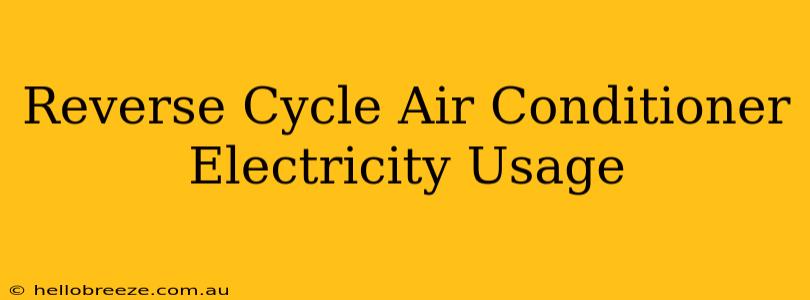Reverse cycle air conditioners, also known as heat pumps, are increasingly popular for their energy efficiency and ability to both heat and cool your home. However, understanding their electricity usage is crucial for budgeting and making informed decisions. This guide will delve into the factors influencing electricity consumption and offer tips for minimizing your energy bill.
Understanding Reverse Cycle Air Conditioner Energy Consumption
The electricity usage of a reverse cycle air conditioner depends on several key factors:
1. Size and Capacity:
- Larger homes require larger units: A unit undersized for your space will work harder and consume more energy, while an oversized unit may cycle on and off frequently, leading to inefficient operation. Proper sizing by a qualified technician is essential.
- BTU Rating (British Thermal Units): This measures the heating and cooling capacity of the unit. A higher BTU rating generally means more powerful cooling and heating but also higher potential electricity consumption. Choose a unit with a BTU rating appropriate for your home's size and climate.
2. Energy Efficiency Rating (EER & SEER):
- EER (Energy Efficiency Ratio): Measures cooling efficiency. A higher EER indicates lower energy consumption for the same amount of cooling.
- SEER (Seasonal Energy Efficiency Ratio): Considers the unit's efficiency over an entire cooling season. A higher SEER rating reflects better overall efficiency. Look for units with high EER and SEER ratings to reduce your electricity bill.
3. Operating Conditions:
- Ambient Temperature: Extreme temperatures (very hot or very cold) will increase electricity usage as the unit works harder to maintain the desired temperature.
- Insulation and Sealing: Poor insulation and air leaks can force your unit to work overtime, resulting in higher electricity consumption. Proper home insulation and sealing are crucial for efficiency.
- Thermostat Settings: Maintaining a consistent temperature rather than constantly adjusting the thermostat can significantly reduce energy usage. Consider programmable or smart thermostats for automated temperature control.
- Usage Habits: How frequently you use your air conditioner directly impacts electricity usage.
4. Maintenance:
- Regular Servicing: Annual maintenance, including filter cleaning and coil cleaning, is essential for optimal performance and reduced energy consumption. A dirty filter restricts airflow, forcing the unit to work harder.
- Refrigerant Levels: Low refrigerant levels can decrease efficiency and increase electricity usage. Professional servicing will ensure proper refrigerant levels.
Minimizing Reverse Cycle Air Conditioner Electricity Usage
Several strategies can help reduce your reverse cycle air conditioner's electricity consumption:
- Improve Home Insulation: Seal air leaks around windows, doors, and other areas to prevent heat loss or gain. Adding insulation to walls and ceilings can significantly reduce the strain on your unit.
- Use a Programmable Thermostat: Set different temperatures for different times of the day to optimize energy use while maintaining comfort.
- Use Fans Strategically: Ceiling fans can help circulate air and reduce the need for the air conditioner to work as hard.
- Regular Maintenance: Schedule annual maintenance to ensure your unit is operating at peak efficiency.
- Shade Your Home: Plant trees or use awnings to shade your home during the hottest part of the day, reducing the cooling load on your air conditioner.
Conclusion: Making Informed Choices
Choosing the right reverse cycle air conditioner, understanding its energy consumption factors, and practicing energy-saving habits can significantly impact your electricity bill. By focusing on efficiency ratings, proper maintenance, and mindful usage, you can enjoy the comfort of your reverse cycle system while minimizing its environmental and financial impact. Remember to consult with qualified professionals for installation and maintenance to ensure optimal performance and long-term savings.

